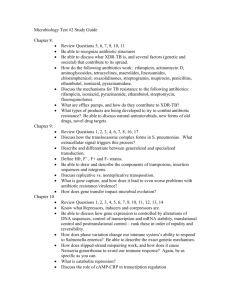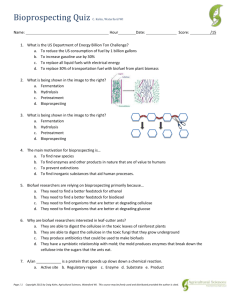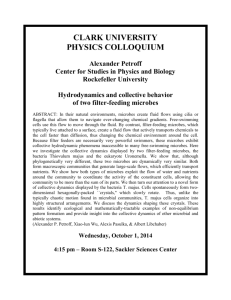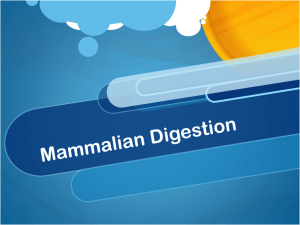Community Method Bioprospecting Lab
advertisement
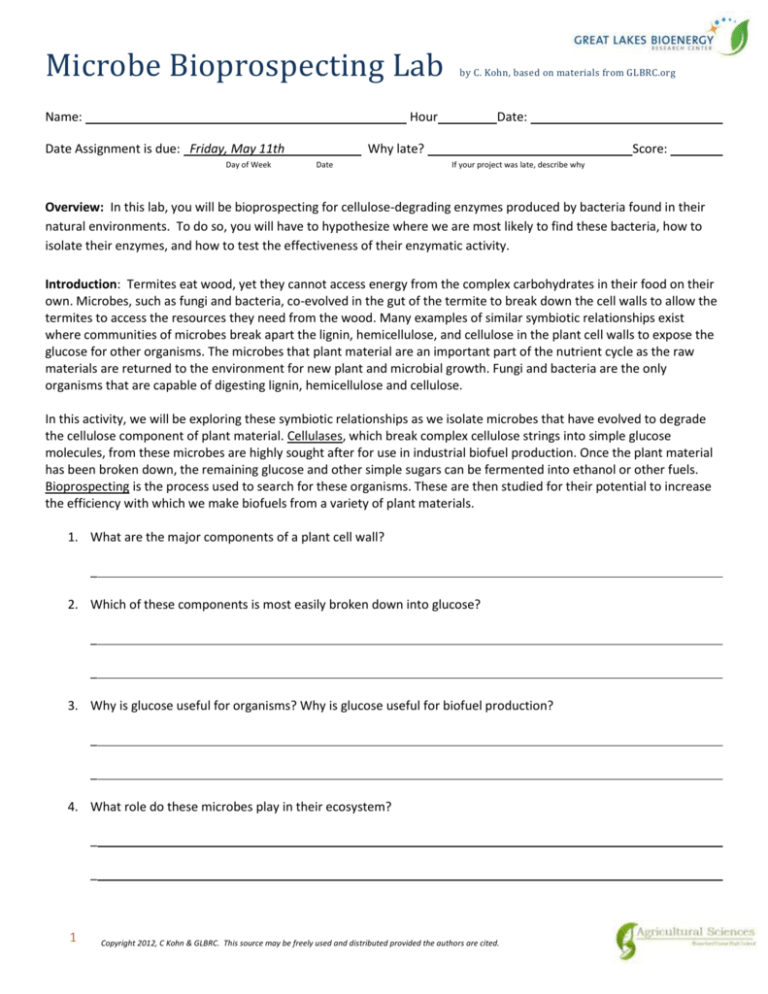
Microbe Bioprospecting Lab Name: by C. Kohn, based on materials from GLBRC.org Hour Date Assignment is due: Friday, May 11th Day of Week Date: Why late? Date Score: If your project was late, describe why Overview: In this lab, you will be bioprospecting for cellulose-degrading enzymes produced by bacteria found in their natural environments. To do so, you will have to hypothesize where we are most likely to find these bacteria, how to isolate their enzymes, and how to test the effectiveness of their enzymatic activity. Introduction: Termites eat wood, yet they cannot access energy from the complex carbohydrates in their food on their own. Microbes, such as fungi and bacteria, co-evolved in the gut of the termite to break down the cell walls to allow the termites to access the resources they need from the wood. Many examples of similar symbiotic relationships exist where communities of microbes break apart the lignin, hemicellulose, and cellulose in the plant cell walls to expose the glucose for other organisms. The microbes that plant material are an important part of the nutrient cycle as the raw materials are returned to the environment for new plant and microbial growth. Fungi and bacteria are the only organisms that are capable of digesting lignin, hemicellulose and cellulose. In this activity, we will be exploring these symbiotic relationships as we isolate microbes that have evolved to degrade the cellulose component of plant material. Cellulases, which break complex cellulose strings into simple glucose molecules, from these microbes are highly sought after for use in industrial biofuel production. Once the plant material has been broken down, the remaining glucose and other simple sugars can be fermented into ethanol or other fuels. Bioprospecting is the process used to search for these organisms. These are then studied for their potential to increase the efficiency with which we make biofuels from a variety of plant materials. 1. What are the major components of a plant cell wall? _ 2. Which of these components is most easily broken down into glucose? _ _ 3. Why is glucose useful for organisms? Why is glucose useful for biofuel production? _ _ 4. What role do these microbes play in their ecosystem? _ _ 1 Copyright 2012, C Kohn & GLBRC. This source may be freely used and distributed provided the authors are cited. Choosing the Sample (to be completed after samples have been collected) Overview: in this portion of the lab, you will be hypothesizing where you are most likely to find the best sources of cellulose-degrading enzymes. Use the questions below as a guide to help prepare you for your bioprospecting journey tomorrow during class. 1. In the space below, list four places that you will visit on Day 2 to bioprospect for microbes. Then list how you will find and collect your microbes for later analysis. Finally state what you expect to find (e.g. fungus decomposer, rumen microbes, digestion-related organism, low-oxygen fermenting organism, etc.). Location 1: What you collected: Rationale for why this was chosen: Location 2: What you collected: Rationale for why this was chosen: Location 3: What you collected: Rationale for why this was chosen: Location 4: What you collected: Rationale for why this was chosen: 2 Copyright 2012, C Kohn & GLBRC. This source may be freely used and distributed provided the authors are cited. 2. Of the sites you and your group stated above, which one does your group believe will provide the greatest abundance of enzymatic activity? List a hypothesis and rationale below: We hypothesize that the following site will produce the greatest abundance of enzymatic activity: _ We think this because _ 3. Of the sites you and your group stated above, which one does your group believe will provide the greatest diversity of enzymatic activity? List a hypothesis and rationale below: We hypothesize that the following site will produce the greatest diversity of enzymatic activity: _ We think this because _ 4. As a group, hypothesize why diversity of enzymatic-producing microbes would be necessary. Then provide three reasons below for why a larger diversity might be important for the efficient breakdown of cellulose: Reason 1 _ Reason 2 _ Reason 3 _ 3 Copyright 2012, C Kohn & GLBRC. This source may be freely used and distributed provided the authors are cited. Testing & Analysis Community Method Instructions: The Community Method explores how the microbes within the environmental sample work together to digest the entire plant, including the cellulose. This method is used by researchers as an initial screen. If they find positive results indicating there is cellulase activity within the sample, they will investigate further to see if it is an individual microbe or if it is a group of microbes interacting in a symbiotic relationship that is responsible for cellulose degradation. You will be adding 2 grams of one of your bioprospected samples to sterilized jars of two kinds of feedstocks – grass clippings and woodchips. Follow the instructions below carefully. Your instructor should create control solutions while you prepare your media for each feedstock. (Steps 1-4 can also be done in advance; consider this if your period is under 60 minutes or if you want to have a class discussion on why each group selected their sample of choice). 1. Begin by adding 2 grams of grass clippings to one jar and 2 grams of woodchips to another jar. 2. Add 50 ml of distilled water to each jar. Cover the jar with a lid but DO NOT apply the ring to the top. Check with your instructor to make sure your jar is prepared properly. 3. Heat the jars on a hot plate until the liquid begins to boil. Immediately cool the liquid and allow it to simmer for 30 minutes. While simmering, answer the questions on the following page. CAUTION: DO NOT allow your solution to boil over. Watch it carefully. Goggles should be worn and extreme caution should be used when handling hot equipment. Wear protection on your hands if needed and/or if instructed. 4. After 30 minutes has passed, allow the solution to cool to 50o C or less. Be sure your thermometer is sterile BEFORE checking the temperature (Lysol and a clean paper towel works fine). 5. Add 2 grams of your bioprospected sample. Seal the lid and ring on your jar. 6. Incubate your samples at room temperature in the location provided to you in the room by your instructor. Shake the samples daily to increase surface contact. 7. After one week (or the amount of time allotted by your instructor), check on your samples. a. The cloudier the sample, the more effectively the cellulose in the sample was broken down. b. The clearer the sample, the less effectively the cellulose was broken down. 8. Compare your samples as a class. Determine the overall most effective bioprospected sample for the entire class. 9. Complete the conclusion questions on the last page. 4 Copyright 2012, C Kohn & GLBRC. This source may be freely used and distributed provided the authors are cited. Sample Preparation Questions (to be answered before incubating your samples): 1. In your group, select the one sample (of your four) that you believe will contain the most effective cellulosedegrading enzymatic activity. Which sample did you select? _ Keep your other samples on hand in case you need them or wish to test them later. 2. Why did you select the sample you wrote above? _ _ _ 3. Why would the organisms in this sample need an abundant production of cellulase enzyme? _ _ 4. Why would we have to sterilize the feedstock solutions (grass clippings and woodchips) before adding our bioprospected samples? _ _ Conclusion Questions: to be completed after the experiment is done. 1. Rank the class’s samples from most effective (most cloudy feedstock solutions) to least effective (clearest) for the grass feedstock. Be sure to describe where each bioprospected sample came from. 1_ 2_ 3_ 4_ 5_ 6_ 5 Copyright 2012, C Kohn & GLBRC. This source may be freely used and distributed provided the authors are cited. 2. Rank the class’s samples from most effective (most cloudy feedstock solutions) to least effective (clearest) for the woodchip feedstock. Be sure to describe where each bioprospected sample came from. 1_ 2_ 3_ 4_ 5_ 6_ 3. Which feedstock was easier to break down, the grass clippings or the woodchips? How do you know? Why do you this feedstock was easier to break down? _ _ 4. Which bioprospected sample do you think would be the most promising as a source of biofuel enzymes? _ Why? _ _ 6 Copyright 2012, C Kohn & GLBRC. This source may be freely used and distributed provided the authors are cited.

